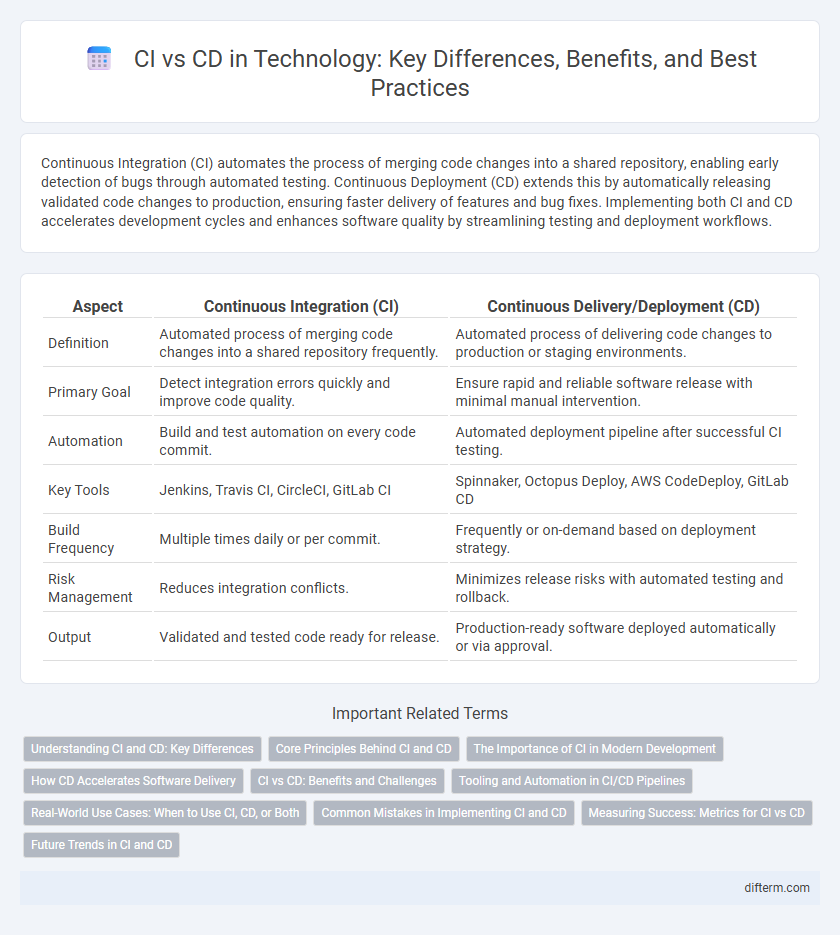Continuous Integration (CI) automates the process of merging code changes into a shared repository, enabling early detection of bugs through automated testing. Continuous Deployment (CD) extends this by automatically releasing validated code changes to production, ensuring faster delivery of features and bug fixes. Implementing both CI and CD accelerates development cycles and enhances software quality by streamlining testing and deployment workflows.
Table of Comparison
| Aspect | Continuous Integration (CI) | Continuous Delivery/Deployment (CD) |
|---|---|---|
| Definition | Automated process of merging code changes into a shared repository frequently. | Automated process of delivering code changes to production or staging environments. |
| Primary Goal | Detect integration errors quickly and improve code quality. | Ensure rapid and reliable software release with minimal manual intervention. |
| Automation | Build and test automation on every code commit. | Automated deployment pipeline after successful CI testing. |
| Key Tools | Jenkins, Travis CI, CircleCI, GitLab CI | Spinnaker, Octopus Deploy, AWS CodeDeploy, GitLab CD |
| Build Frequency | Multiple times daily or per commit. | Frequently or on-demand based on deployment strategy. |
| Risk Management | Reduces integration conflicts. | Minimizes release risks with automated testing and rollback. |
| Output | Validated and tested code ready for release. | Production-ready software deployed automatically or via approval. |
Understanding CI and CD: Key Differences
Continuous Integration (CI) is the practice of automatically merging all developers' working copies to a shared mainline several times a day, emphasizing early error detection through automated testing. Continuous Delivery (CD) extends this process by ensuring that the integrated code is always in a deployable state, facilitating frequent and reliable software releases to production. The key difference lies in CI focusing on integration and testing automation, while CD prioritizes deployment automation and release readiness.
Core Principles Behind CI and CD
Continuous Integration (CI) emphasizes the practice of merging code changes frequently into a shared repository, promoting automated testing and early detection of integration issues to ensure code quality. Continuous Delivery (CD) extends CI by automating the deployment process, enabling teams to release software updates quickly, reliably, and with minimal manual intervention. Both CI and CD rely on automation, frequent code commits, and rigorous testing to enhance software development efficiency and maintain stability in production environments.
The Importance of CI in Modern Development
Continuous Integration (CI) is crucial in modern development as it enables developers to merge code changes frequently, reducing integration conflicts and accelerating bug detection. Automated testing within CI pipelines ensures code quality and stability, leading to faster release cycles and more reliable software delivery. By fostering collaboration and immediate feedback, CI enhances development efficiency and supports agile methodologies effectively.
How CD Accelerates Software Delivery
Continuous Deployment (CD) automates the release process, enabling faster delivery of software updates directly to production environments. By minimizing manual intervention, CD reduces the feedback loop, allowing developers to detect and resolve issues swiftly. This acceleration enhances customer satisfaction through rapid feature delivery and quicker bug fixes.
CI vs CD: Benefits and Challenges
Continuous Integration (CI) accelerates software development by automating code integration, reducing bugs through frequent testing, and enhancing collaboration among developers. Continuous Delivery (CD) enables faster and more reliable software releases by automating deployment processes, improving feedback loops, and ensuring consistent delivery to production environments. Challenges in CI include managing merge conflicts and maintaining test reliability, while CD faces hurdles like deployment automation complexity and ensuring environment consistency across stages.
Tooling and Automation in CI/CD Pipelines
CI/CD pipelines leverage specialized tooling to automate software integration, testing, and deployment processes, enhancing development velocity and reliability. Continuous Integration (CI) tools like Jenkins, Travis CI, and CircleCI automate code builds and unit testing, ensuring early detection of integration issues. Continuous Delivery (CD) platforms such as Spinnaker and Argo CD automate deployment workflows to staging and production environments, promoting rapid and consistent software releases.
Real-World Use Cases: When to Use CI, CD, or Both
Continuous Integration (CI) is ideal for early-stage software development where frequent code commits and automated testing ensure code quality and rapid bug detection. Continuous Delivery (CD) extends CI by automating the release of validated code to production-like environments, making it suitable for teams aiming for consistent, reliable deployments. Both CI and CD are combined in mature DevOps practices to accelerate development cycles, improve collaboration, and maintain high software quality in complex, evolving projects.
Common Mistakes in Implementing CI and CD
Common mistakes in implementing Continuous Integration (CI) and Continuous Deployment (CD) include neglecting automated testing, leading to integration of unstable code, and failing to maintain a consistent build environment, which causes deployment inconsistencies. Overlooking proper version control and inadequate monitoring can result in undetected errors and deployment failures. Teams often underestimate the importance of clear communication and documentation, which impairs collaboration and slows down the CI/CD pipeline effectiveness.
Measuring Success: Metrics for CI vs CD
Measuring success in Continuous Integration (CI) relies heavily on metrics such as build frequency, build success rate, and code integration time to ensure code quality and early defect detection. Continuous Deployment (CD) focuses on deployment frequency, lead time for changes, change failure rate, and mean time to recovery (MTTR) to gauge delivery speed and system stability. Monitoring these key performance indicators (KPIs) enables teams to optimize development workflows and accelerate software delivery.
Future Trends in CI and CD
Future trends in Continuous Integration (CI) and Continuous Deployment (CD) emphasize increased automation driven by AI and machine learning, enhancing predictive analytics for faster error detection. Integration of containerization technologies like Kubernetes with CI/CD pipelines accelerates scalable application delivery across cloud-native environments. Security in DevOps pipelines advances through automated compliance checks and shift-left testing, ensuring robustness in increasingly complex software ecosystems.
CI vs CD Infographic

 difterm.com
difterm.com